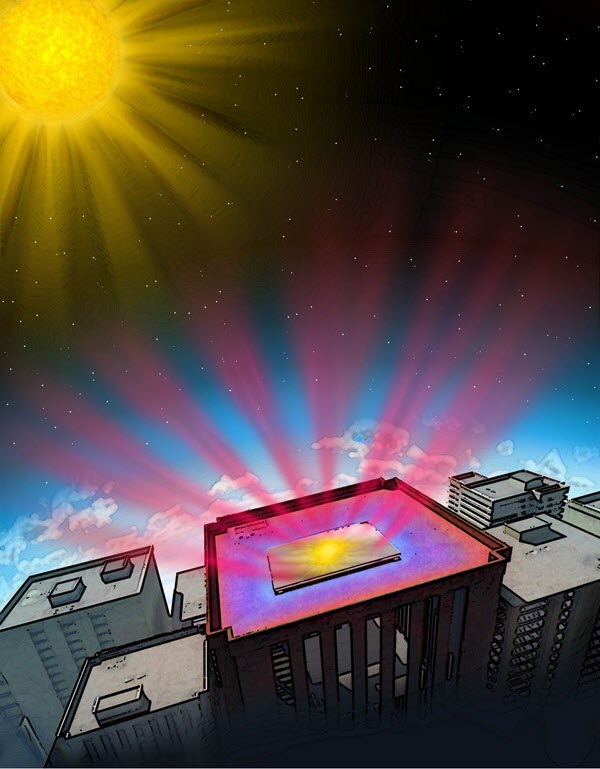Transparent photonic coating cools solar cells to boost efficiency
September 21, 2015

Stanford engineers have invented a transparent material that improves the efficiency of solar cells by radiating thermal energy (heat) into space (credit: Stanford Engineering)
Stanford engineers have developed a transparent material that improves the efficiency of solar cells by radiating thermal energy (heat) into space, even in full sunlight.
The invention may solve a longstanding problem for the solar industry: the hotter solar cells become, the less efficient they are at converting sunlight to electricity. The Stanford solution is based on a thin, patterned silica material laid on top of a traditional solar cell. The material is transparent to the visible sunlight that powers solar cells, but captures and emits thermal radiation, or heat, cooling the solar cell and thus allowing it to convert more photons into electricity.
The work by Shanhui Fan, a professor of electrical engineering at Stanford, research associate Aaswath P. Raman and doctoral candidate Linxiao Zhu is described in the current issue of Proceedings of the National Academy of Sciences.
The same inventors previously developed an ultrathin material, covered on KurzweilAI, that radiated infrared light (in the thermal “long” infrared atmospheric transparency window of ~7 to 30 microns) from the Sun directly back toward space without warming the atmosphere (thus avoiding the greenhouse effect). They presented that work in Nature, describing it as “radiative cooling” because it shunted thermal energy directly into the deep, cold void of space. It was specifically intended for cooling buildings.
A silica photonic crystal radiator
In their new paper, the researchers applied that work to improve solar array performance.

Silica photonic crystal radiates far-infrared light (heat) into space (credit: Linxiao Zhu et al./PNAS)
The Stanford team tested their technology on a custom-made solar absorber — a device that mimics the properties of a solar cell without producing electricity — covered with a silica photonic crystal (a micrometer-scale pattern) designed to maximize the capability to dump heat, in the form of infrared light (in 8 to 30 microns range) into space. Their experiments showed that the overlay allowed visible light to pass through to the solar cells, but that the pattern also cooled the underlying absorber by as much as 23 degrees Fahrenheit.
For a typical crystalline silicon solar cell with an efficiency of 20 percent, 23 F of cooling would improve absolute cell efficiency by more than 1 percent, a figure that represents a significant gain in energy production.
The researchers said the new transparent thermal overlays work best in dry, clear environments, which are also preferred sites for large solar arrays. They believe they can scale things up so that commercial and industrial applications are feasible, perhaps using nanoprint lithography, which is a common technique for producing nanometer-scale patterns.
Cooler cars
Zhu said the technology has significant potential for any outdoor device or system that demands cooling but requires the preservation of the visible spectrum of sunlight for either practical or aesthetic reasons.
“Say you have a car that is bright red,” Zhu said. “You really like that color, but you’d also like to take advantage of anything that could aid in cooling your vehicle during hot days. Thermal overlays can help with passive cooling, but it’s a problem if they’re not fully transparent.” That’s because the perception of color requires objects to reflect visible light, so any overlay would need to be transparent, or else tuned such that it would absorb only light outside the visible spectrum.
“Our photonic crystal thermal overlay optimizes use of the thermal portions of the electromagnetic spectrum without affecting visible light,” Zhu said, “so you can radiate heat efficiently without affecting color.”
Abstract of Radiative cooling of solar absorbers using a visibly transparent photonic crystal thermal blackbody
A solar absorber, under the sun, is heated up by sunlight. In many applications, including solar cells and outdoor structures, the absorption of sunlight is intrinsic for either operational or aesthetic considerations, but the resulting heating is undesirable. Because a solar absorber by necessity faces the sky, it also naturally has radiative access to the coldness of the universe. Therefore, in these applications it would be very attractive to directly use the sky as a heat sink while preserving solar absorption properties. Here we experimentally demonstrate a visibly transparent thermal blackbody, based on a silica photonic crystal. When placed on a silicon absorber under sunlight, such a blackbody preserves or even slightly enhances sunlight absorption, but reduces the temperature of the underlying silicon absorber by as much as 13°C due to radiative cooling. Our work shows that the concept of radiative cooling can be used in combination with the utilization of sunlight, enabling new technological capabilities.